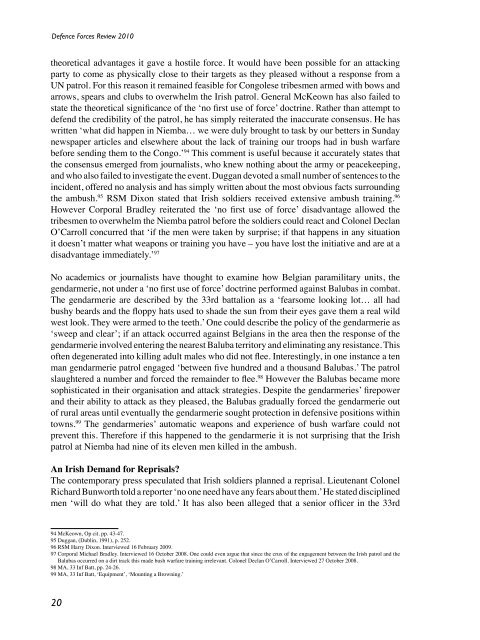Defence Forces Review 2010
Defence Forces Review 2010
Defence Forces Review 2010
You also want an ePaper? Increase the reach of your titles
YUMPU automatically turns print PDFs into web optimized ePapers that Google loves.
<strong>Defence</strong> <strong>Forces</strong> <strong>Review</strong> <strong>2010</strong>theoretical advantages it gave a hostile force. It would have been possible for an attackingparty to come as physically close to their targets as they pleased without a response from aUN patrol. For this reason it remained feasible for Congolese tribesmen armed with bows andarrows, spears and clubs to overwhelm the Irish patrol. General McKeown has also failed tostate the theoretical significance of the ‘no first use of force’ doctrine. Rather than attempt todefend the credibility of the patrol, he has simply reiterated the inaccurate consensus. He haswritten ‘what did happen in Niemba… we were duly brought to task by our betters in Sundaynewspaper articles and elsewhere about the lack of training our troops had in bush warfarebefore sending them to the Congo.’ 94 This comment is useful because it accurately states thatthe consensus emerged from journalists, who knew nothing about the army or peacekeeping,and who also failed to investigate the event. Duggan devoted a small number of sentences to theincident, offered no analysis and has simply written about the most obvious facts surroundingthe ambush. 95 RSM Dixon stated that Irish soldiers received extensive ambush training. 96However Corporal Bradley reiterated the ‘no first use of force’ disadvantage allowed thetribesmen to overwhelm the Niemba patrol before the soldiers could react and Colonel DeclanO’Carroll concurred that ‘if the men were taken by surprise; if that happens in any situationit doesn’t matter what weapons or training you have – you have lost the initiative and are at adisadvantage immediately.’ 97No academics or journalists have thought to examine how Belgian paramilitary units, thegendarmerie, not under a ‘no first use of force’ doctrine performed against Balubas in combat.The gendarmerie are described by the 33rd battalion as a ‘fearsome looking lot… all hadbushy beards and the floppy hats used to shade the sun from their eyes gave them a real wildwest look. They were armed to the teeth.’ One could describe the policy of the gendarmerie as‘sweep and clear’; if an attack occurred against Belgians in the area then the response of thegendarmerie involved entering the nearest Baluba territory and eliminating any resistance. Thisoften degenerated into killing adult males who did not flee. Interestingly, in one instance a tenman gendarmerie patrol engaged ‘between five hundred and a thousand Balubas.’ The patrolslaughtered a number and forced the remainder to flee. 98 However the Balubas became moresophisticated in their organisation and attack strategies. Despite the gendarmeries’ firepowerand their ability to attack as they pleased, the Balubas gradually forced the gendarmerie outof rural areas until eventually the gendarmerie sought protection in defensive positions withintowns. 99 The gendarmeries’ automatic weapons and experience of bush warfare could notprevent this. Therefore if this happened to the gendarmerie it is not surprising that the Irishpatrol at Niemba had nine of its eleven men killed in the ambush.An Irish Demand for Reprisals?The contemporary press speculated that Irish soldiers planned a reprisal. Lieutenant ColonelRichard Bunworth told a reporter ‘no one need have any fears about them.’ He stated disciplinedmen ‘will do what they are told.’ It has also been alleged that a senior officer in the 33rd94 McKeown, Op cit. pp. 43-47.95 Duggan, (Dublin, 1991), p. 252.96 RSM Harry Dixon. Interviewed 16 February 2009.97 Corporal Michael Bradley. Interviewed 16 October 2008. One could even argue that since the crux of the engagement between the Irish patrol and theBalubas occurred on a dirt track this made bush warfare training irrelevant. Colonel Declan O’Carroll. Interviewed 27 October 2008.98 MA, 33 Inf Batt, pp. 24-26.99 MA, 33 Inf Batt, ‘Equipment’, ‘Mounting a Browning.’20
















